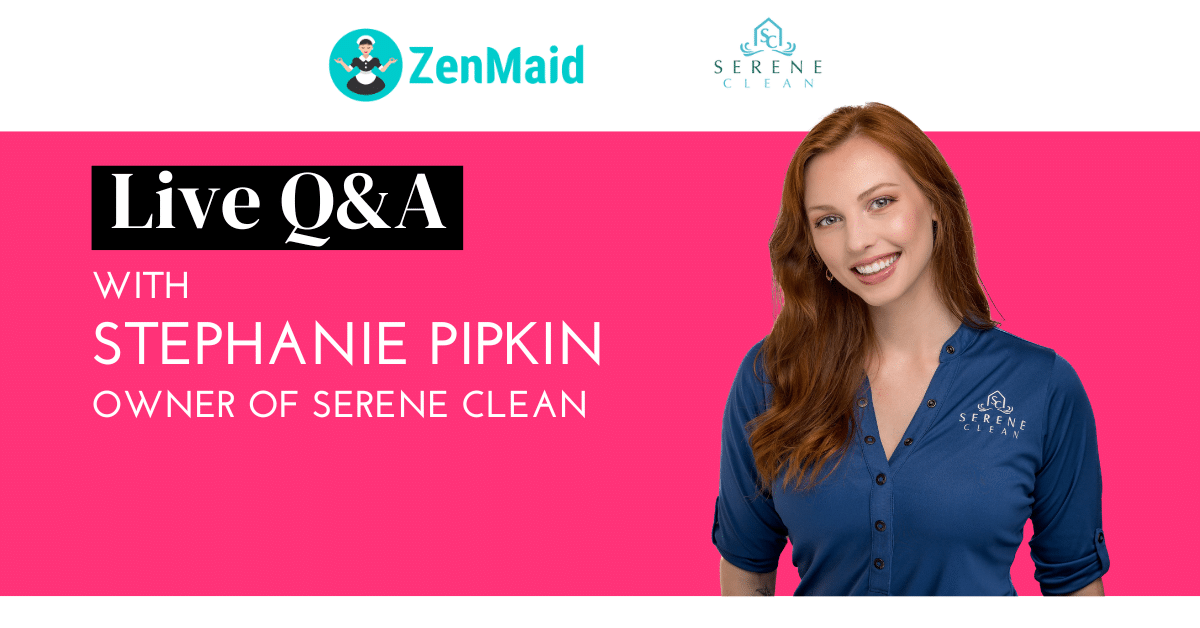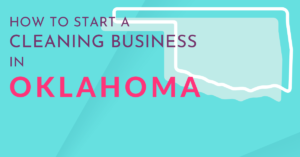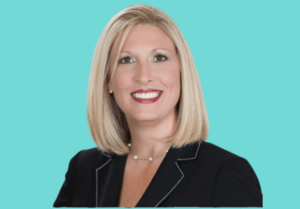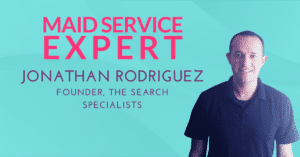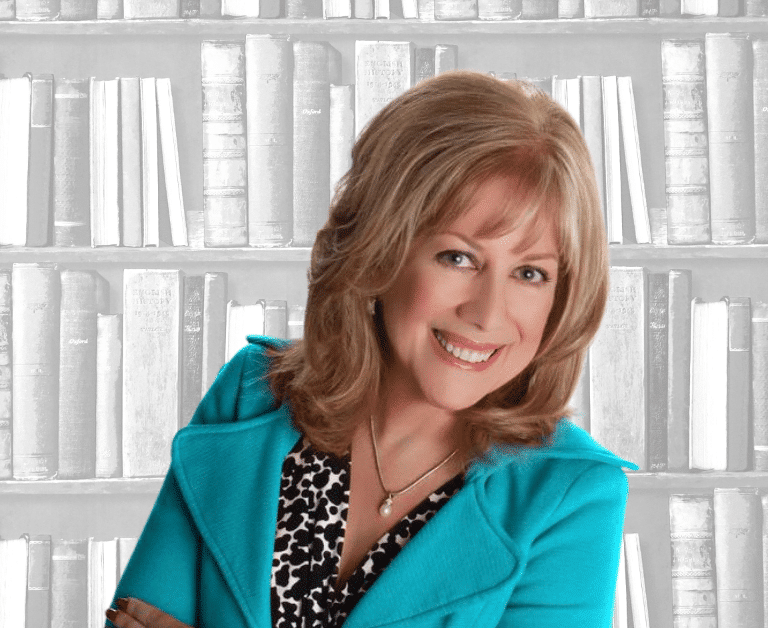Last Updated on May 2, 2024 by The ZenMaid Team
Stephanie Pipkin is the owner of Serene Clean, a Wisconsin-based cleaning company that has grown from $0 to $1.5 million in yearly revenue in under 5 years. As one of our partnering industry leaders at ZenMaid, Stephanie hosted a live Q&A in our free Facebook Group: The ZenMaid Mastermind.
We’ve broken down the key takeaways to read in this post. You can watch the full video replay right here. (Please request access if you’re not already one of our 8,000+ members of savvy maid service owners.)
Q: “How do you determine your business profit?”
Stephanie highlights the variability of profit margins across businesses, stressing the importance of not comparing one’s figures too closely with others. She explains that many factors can affect profitability, such as management expenses and community contributions. For her, achieving life and time freedom by employing three managers, even if it means lower profits, is worthwhile. Stephanie mentions aiming for a profit margin of 15-20%, including the owner’s salary but acknowledges that it’s not always attainable. Revenue can also fluctuate, ranging from $110,000 to $130,000 monthly, and her take-home percentage is around 6-8% of total revenue. Stephanie also recommends the “Profit First” methodology as an effective way to manage business finances.
Q: “What strategies do you use for effective hiring?”
In tackling hiring challenges, Stephanie advocates for continuously posting job listings on platforms like Indeed and enhancing visibility through videos of current employee interviews on both Indeed and YouTube. With changes to Facebook’s job listing policies, she now boosts hiring posts to increase reach. She suggests focusing on group interviews rather than individual sessions to save time and improve the efficiency of the hiring process. Local buy-sell-trade groups are also useful for attracting local interest in job openings.
“We interview every single day. Most don’t show up to the interview they set up or aren’t a fit. So that’s it’s okay interviewing every day. Focus on group interview style.”
Stephanie shares an anecdote to emphasize the importance of being cautious and informed about hiring laws to avoid legal pitfalls. She advises against asking prohibited questions and recommends simply informing unsuccessful candidates that another route has been chosen if needed. This approach minimizes potential legal issues while maintaining professionalism in the hiring process.
“When in doubt, I wouldn’t even explain why you didn’t choose somebody, just say you chose to go a different route.”
Q: “Where do you get your leads and customers from?”
Stephanie shares that the majority of her business leads come from Google and her company’s website. The key to their success in generating leads is maintaining a robust online presence through continuous updates and engagement on their Google My Business profile. This includes regularly adding photos, securing reviews, and updating posts to demonstrate relevance. She emphasizes the importance of not only having a large number of reviews but also ensuring they are genuine and interacted with.
Stephanie also underscores the role of a well-designed website in attracting customers, offering an online presence that truly represents the brand. She mentions a Maid Summit talk titled “The Clear Choice: Standing Out in a Sea of Options” which focuses on enhancing online visibility against competitors. While Facebook and word of mouth also contribute to lead generation, Stephanie advises not to rely solely on these as they are not scalable solutions for sustainable business growth.
She recommends establishing multiple Google locations corresponding to physical or virtual offices to ensure visibility in those regions. This strategic placement helps in capturing leads from various locations, making the business more accessible and top-of-mind for potential customers in those areas.
Q: “What is your policy if a cleaner doesn’t complete a job?”
Stephanie explains the importance of having a clear policy in place for handling situations where a cleaner does not complete a job to the required standards. She stresses the necessity of having such policies documented and signed by employees to ensure legal protection and clarity. In her business, when a quality issue arises, it is documented and immediately addressed. If a second cleaner has to correct the work, the original cleaner’s pay is docked to the minimum wage for the time it took to make the corrections.
Stephanie emphasizes that this policy is not about penalizing employees harshly but about ensuring they feel the impact of their performance on their earnings, which she finds effective in reducing complaints and improving quality. The policy, including specific disciplinary measures and financial consequences, is communicated to employees during the orientation process and is part of the signed employment documents, which are managed through their payroll software, Gusto. This approach has led to a significantly low complaint rate and a more efficient and accountable cleaning service.
“We have a less than 0.7% complaint rate with anywhere from 160 to 200 appointments a week.”
Download directly Stephanie’s Quality Standard Policy:
Q: “How do you address false negative reviews on Google?”
Stephanie shares her frustration with receiving inaccurate one-star reviews on Google, acknowledging how detrimental they can be to a business. She advises contacting Google to speak directly with a representative and suggests hiring a consultant who specializes in dealing with Google issues. To combat false reviews, recommends rallying friends and family to report them as well, emphasizing that a collective effort can make a difference. She also hints at understanding the nature of these reviews—whether they come from confusion or malicious intent—since the strategy might vary accordingly. For instance, if a review clearly states it’s from a disgruntled former employee, it’s typically easier to have it removed.
Q: “How do you differentiate your business from a similarly named competitor on Google?”
Addressing the issue of mistaken identity due to similar business names, Stephanie recommends differentiating your business on Google. She suggests modifying the business title to clearly indicate the geographic area served and making a note in the Google My Business description about the mix-up. Responding professionally to incorrect reviews is crucial as it helps clarify the confusion for potential customers and demonstrates proactive customer service.
Q: “How should you categorize the cost of training new hires in your financial records?”
Stephanie addresses the query regarding whether training costs for new hires should be categorized under cost of goods sold (COGS) or as operating expenses. In her company, all payroll-related expenses, including training, are categorized as operating expenses. She emphasizes the importance of how financial categorization influences business decisions rather than strictly adhering to a specific method. If specific insight into training costs is needed, she suggests running detailed reports by employees. Stephanie shares her approach of keeping payroll expenses categorized under management and technician wages separately within operating expenses to maintain clarity and assist in effective financial planning.
Classify training costs under operating expenses for clearer financial oversight and to simplify management of payroll-related expenditures.
Stephanie elaborates on the management of payroll expenses, noting that a significant portion of her revenue—about 60 to 70%, sometimes even more depending on the payroll frequency in a given month—goes towards payroll costs. These expenses include salaries for cleaners and managers, payroll taxes, benefits, and travel costs like mileage. She advises that these costs can substantially impact a business’s bottom line, especially during months with multiple payroll periods which might only allow for breaking even.
Q: “Starting in cleaning services, should you focus on one type of cleaning?”
Stephanie advises new business owners in the cleaning industry to start by focusing on a specific genre of cleaning, such as residential or commercial, to avoid operational chaos. She reflects on her own experience, initially offering residential cleaning before expanding to commercial services, which extended her working hours significantly. Stephanie now recommends setting operational limits, such as restricting commercial cleaning services to daytime hours to avoid logistical nightmares, like staff no-shows during late-night shifts. She emphasizes the importance of having clear scopes of work and checklists for each cleaning type, which helps in scaling and training staff effectively.
New business owners should not shy away from commercial opportunities as cleaning fundamentals remain similar across different types, but organizational strategies like detailed checklists are essential for managing varied cleaning tasks efficiently.
Stephanie discusses the importance of creating customized checklists for commercial clients to ensure that every specific cleaning requirement is met. She uses a template for checklists that is adjusted based on individual client needs. This method helps maintain high standards across different cleaning scenarios and client expectations. For residential cleanings, each client receives a completed checklist at the end of every service, which is crucial for maintaining transparency and accountability.
“In commercial cleaning, we tailor our cleaning checklists to each client’s.”
Q: “How do you handle payroll data integration with Gusto?”
Stephanie describes her process of transferring payroll data into Gusto, emphasizing manual entry to ensure accuracy. She calculates payroll using ZenMaid, which helps streamline the process by making it easy to track clock-in and clock-out times. Tips and mileage are entered manually into Gusto to maintain precise records. This meticulous approach ensures that payroll is not only accurate but also reflects the actual work and travel time of employees.
“Manual payroll entry might require extra effort, but it lets us address any specific payroll components like tips and mileage.”
Q: “What does your cleaning supply kit include?”
“Our cleaning kits are designed to be natural, affordable, and highly effective. We start with the basics like Dawn dish soap mixed with water and a few drops of essential oils to create an all-purpose cleaner. Our glass cleaner is simply half vinegar and half water. For mopping, we use hot water with Dawn and essential oils. These simple ingredients form the backbone of our cleaning process, covering the majority of household cleaning needs.”
“For tougher jobs, we use Bar Keepers Friend Soft Scrub and occasionally a drill with scrub brush attachments for intense cleaning sessions like move-outs or first-time cleans. The only strong chemical we employ is oven cleaner, to expedite cleaning during tougher jobs. Our kits also include essentials like a good vacuum—our preference is Shark vacuums—and a basic cleaning caddy from Walmart.”
Direct Download:
“We believe in keeping our cleaning kits simple and natural, without compromising on effectiveness.”
Q: “What about uniforms and other equipment for your cleaning staff?”
“Uniforms and equipment are an integral part of our brand. Each cleaner has a designated vacuum and wears a polo shirt, which we find presents a professional appearance. We choose to have our uniforms embroidered rather than screen printed to ensure longevity and prevent fading. Our cleaners also wear comfortable pants in neutral colors to match the company’s branding and clean shoes. Aprons are crucial as they hold all necessary tools, akin to a tool belt.”
“Professional attire and effective tools are key to maintaining our brand’s standard.”
Q: “Why should I use ZenMaid as my scheduling software?“
Stephanie uses ZenMaid specifically because it’s tailored to the needs of cleaning company owners. She appreciates its targeted features, such as tools for managing recurring services and the SpotFinder tool, which are particularly beneficial for the cleaning industry. ZenMaid’s focus on providing functionalities that help in operational efficiency for cleaning businesses sets it apart from more generalized platforms like Jobber, which cater to a broader range of services.
She highlights the user-friendliness of ZenMaid, noting its ease of use even for those who are not very tech-savvy, making it a valuable tool for training and managing staff. Additionally, Stephanie points out ZenMaid’s scalability and affordability, emphasizing that the system grows effectively with the business as new cleaners are added, making it a cost-effective solution for expanding operations.
Q: “How can others access your resources and templates?”
“I offer a variety of resources through my consulting website, which includes bundles of documents that have been crucial in the scaling and efficiency of our business. These resources cover everything from client guidelines and employee documents to sales scripts and kit diagrams. While these templates are tailored specifically for cleaning businesses, they’re part of a broader strategy that emphasizes learning through trial and error, which can be applicable in many contexts.”
“For those interested, we’ll provide a link to my consulting page where these resources are available for purchase. However, there are also many free templates online that can serve as a starting point for those looking to streamline their operations.”
Q: “Do you employ W2 workers or 1099 contractors for cleaning?”
“We exclusively use W2 employees for all our cleaning services.” The choice between hiring W2 employees and 1099 contractors is significant, primarily due to legal distinctions and control over work processes. With 1099 contractors, they must operate as independent entities, possessing their own tools, insurance, and cannot be tightly managed by the hiring company. “This level of independence often doesn’t align with how we want to run operations, as I prefer to have complete control to ensure consistency and quality.”
Employing W2 workers allows Stephanie to manage all aspects of the job and maintain a standard of work that matches her company’s values and practices. Although this means bearing the full cost of employment, including payroll taxes and workers’ compensation, it provides the necessary level of oversight and integration into her team, which is crucial for delivering the quality promised to the clients.
Using W2 employees allows Stephanie to maintain high standards and control, essential for the quality and consistency she aims for.
Q: “Can you share the checklists used for your cleaning services?
“Certainly! For every cleaning session, whether it’s a first-time clean or routine maintenance, we use a detailed standard cleaning checklist. This checklist ensures that every corner of the home is attended to and allows us to offer premium services, not just basic wipe-downs. Our standard checklist includes tasks like cleaning blinds, window tracks, and interior windows, along with options for additional services like cleaning inside appliances and cupboards.”
For deep cleans, particularly in vacant homes, her checklist is even more exhaustive. This includes tasks like washing walls and cleaning every imaginable surface, ensuring a thorough clean. These deep cleans are designed for unoccupied homes, as the level of detail required is not feasible in a lived-in space.
Checklists are crucial for setting clear expectations with our clients and staff. By being transparent about what each type of cleaning entails, they avoid misunderstandings and ensure that everyone knows exactly what to expect. “We also provide these checklists to clients with our estimates, so they understand the scope of work from the outset.”
Direct Download:
Q: “How do you handle the tough moments in business?”
During challenging times, it’s crucial to step back and analyze the situation systematically. When feeling overwhelmed, she recommends getting everything down on paper. Write out exactly what’s happening and why it’s affecting you. This can lead to identifying whether issues stem from pricing, lack of procedures, or something else.
“In my experience, many problems arise from not having established procedures to handle recurring issues.” Creating simple systems, such as protocols for when a cleaner calls out or a client cancels, can significantly reduce stress and chaos. These systems don’t have to be complex; they just need to outline a clear response for each scenario.
Raising prices is another solution that often feels counterintuitive but can address multiple issues simultaneously. If you’re not charging enough, you might struggle to attract quality hires or sustain your business financially. Industry standards suggest a minimum of $45 per man-hour, which should be adjusted based on your geographic location and operating costs.
“Writing down problems and creating straightforward procedures can transform overwhelming challenges into manageable tasks.”
Q: “What should your pricing strategy be in the cleaning industry?”
Pricing correctly is pivotal. If your rates are too low, it might signal to potential clients that your service lacks quality. Conversely, if your prices are consistently met with resistance, it may be time to enhance how your business presents itself through professional branding, a well-crafted website, and branded communications.
“For instance, in rural Western Wisconsin, we charge $55 per man-hour for residential cleaning, which is competitive yet fair given our quality of service.” It’s essential to remember that prices can always be adjusted. If a price increase leads to a decrease in clients, reassess and adapt. The goal is to find a balance where your clients feel the value justifies the cost, and if demand is high, consider raising prices to better match the market.
Scalability in the cleaning business heavily depends on adjusting prices according to demand and operational costs. “Whenever we’ve faced hiring difficulties or operational bottlenecks, we’ve found that raising our prices and, consequently, wages, helps us overcome these hurdles.” This approach ensures that Stephanie can maintain a manageable client load while improving service quality and staff satisfaction.
“If a pricing experiment doesn’t work out, you’re always free to adjust again.” The key is to remain flexible and responsive to market feedback while ensuring your business remains profitable and sustainable.
“If a pricing experiment doesn’t work out, you’re always free to adjust again.”
Q: “What are the top tools for running your business?”
Here are Stephanie’s top 5 tools to run her cleaning business:
- ZenMaid: Loved by thousands, ZenMaid is the best CRM and scheduling software built for maid services businesses. With tools like all-in-one scheduling, automated reminders via email and SMS, booking forms, integrations, and a user-friendly app for staff to use, ZenMaid makes it easier to grow your cleaning business. (Try it for free!)
- QuickBooks Online: This bookkeeping software integrates with ZenMaid and simplifies financial tracking, invoicing, and provides valuable reports to informed decision-making.
- Gusto: A payroll platform that automates essential tasks like reporting new hires to the state and managing tax withholdings, streamlining payroll processes.
- SurveyMonkey: Utilized for gathering feedback from both customers and employees, aiding in continuous improvement and customer satisfaction.
- Canva: A tool for creating visual content, essential for marketing, branding, and internal communications.
And there’s even more…
Watch Stephanie break down all of these insights and more in the Q&A replay. And don’t miss the next live Q&A with our ZenMaid cleaning business experts.
Sign up for our free Facebook group, The ZenMaid Mastermind, to grow your maid service alongside our community of 8,000+ owners just like you.
See you there!

